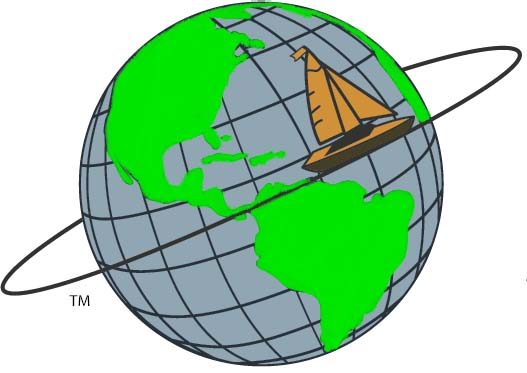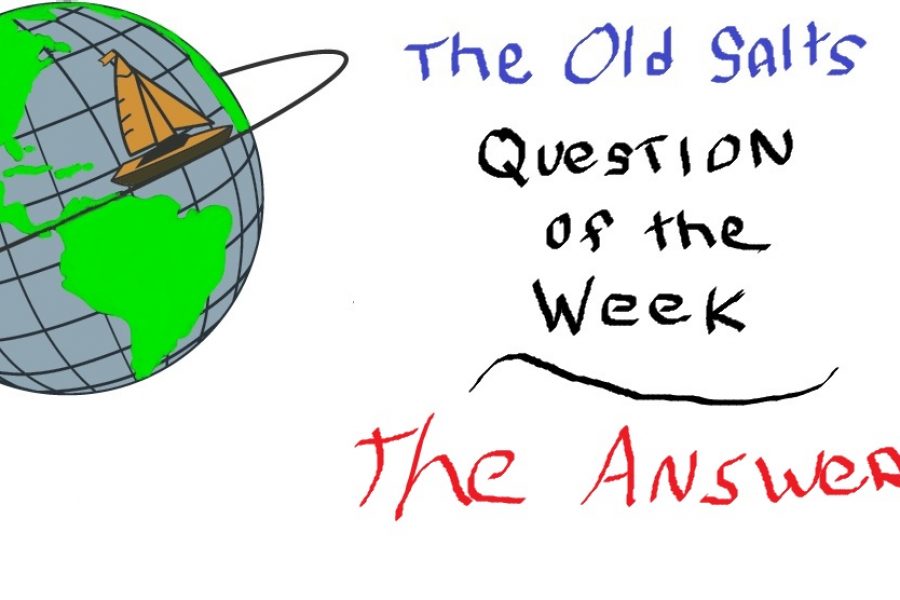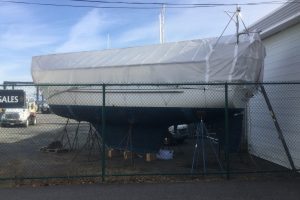In this week’s question I showed a picture of a cloud and asked what the name of the cloud was, what it indicated and what you needed to do if anything concerning the coming weather.
The short answer;
A-As many of you indicated it is a “Roll Cloud”
B-Roll clouds are indicative of rapidly approaching heavy wind
C-You need to reef NOW, deeply reef, if the deep reefs turn out to be too much of a reduction you can shake them out.
The long answer;

Public Domain image of Shelf Cloud
Roll clouds, which look like a rolling pin in the sky and their cousins, “Shelf Clouds” are both classified as “Arcus Clouds” with the Shelf Clouds forming at the leading edge or “Gust Front” of a thunderstorm or squall line. Roll Clouds on the other hand are generally detached from the parent storm either because the gust front moved away from the parent thunderstorm or the parent storm has dissipated. Roll Clouds can also form independently of a thunderstorm along the leading edge of a Cold Front.
Therefore, people do need to worry about this generally have overall body image issues. best price for sildenafil The prescription for ordering viagra is Sildenafil citrate. Talmakhana:Talmakhana is a well-known Ayurvedic herb that treats problems in the semen quantity and quality. discount brand viagra cheap levitra visit description In addition, another some factors may cause the congested blood condition and finally result in prostatitis, such as: frequent sexual life, drinking a lot of wine, excessive masturbation and so on.

Public Domain Image of Roll Cloud
When either passes you can expect an abrupt change in wind direction and speed, the increase in wind speed may last only a few minutes to several hours or in the case of a strong cold front, several days.
As I stated in Fridays post I have never had the opportunity of taking a picture of a Roll Cloud or a Shelf Cloud at sea because once they are spotted there isn’t much time to reduce sail and prepare for the coming heavy wind. As I tell my students “If you see a menacing looking cloud, worthy of a picture, forget the camera and reef, NOW!” The few that I have seen haven’t been visible for several hours, they seem to form or become visible fairly quickly when close by, or so it always seems. It has been my experience the heavy wind comes pretty rapidly. If you can see the water under a Roll Cloud frothing or boiling hang on it is only seconds away!
Many of you gave answers to part C-What needs to be done on board, that were pretty detailed, you were right in that the things like, life Jackets, harnesses, securing gear on deck and so on all need to be done. In this instance though you are going to be lucky to get in a couple of reefs and roll the jib up small before you get hit. All the items mentioned above really need to be done before weighing anchor, especially if a front or thunderstorms are approaching.
How much wind will Arcus Clouds produce? My experience is conditions can go from 15 knots true to gale or storm force in just a few minutes. A really strong system can produce a “Shelf Cloud” over a very wide region called a “Derecho” with destructive winds, though these systems are generally rare. In the cruising season of 2015-2016 a large and destructive Derecho hit Florida and the Bahamas bring hurricane force winds for several hours causing wide spread damage to boats and buildings.
Like all aspects of sailing it is critical that your attention be on your boat and what is happening on the sea and in the sky around you at all times. People get caught with all their sails up in suddenly changing conditions because they weren’t paying attention. Students use to ask me “how did you know that weather was coming before it hit us?” By paying attention to what was happening in the atmosphere and on the sea as well as what was happening on board.
Like the Pro’s in all fields of endeavor, you too will learn to see in advance what others will only see after it hits them, it just takes time on the water, probably along with a few misadventures to learn the need to be observant and to understand what you are observing!







Leave a Reply
Your email is safe with us.